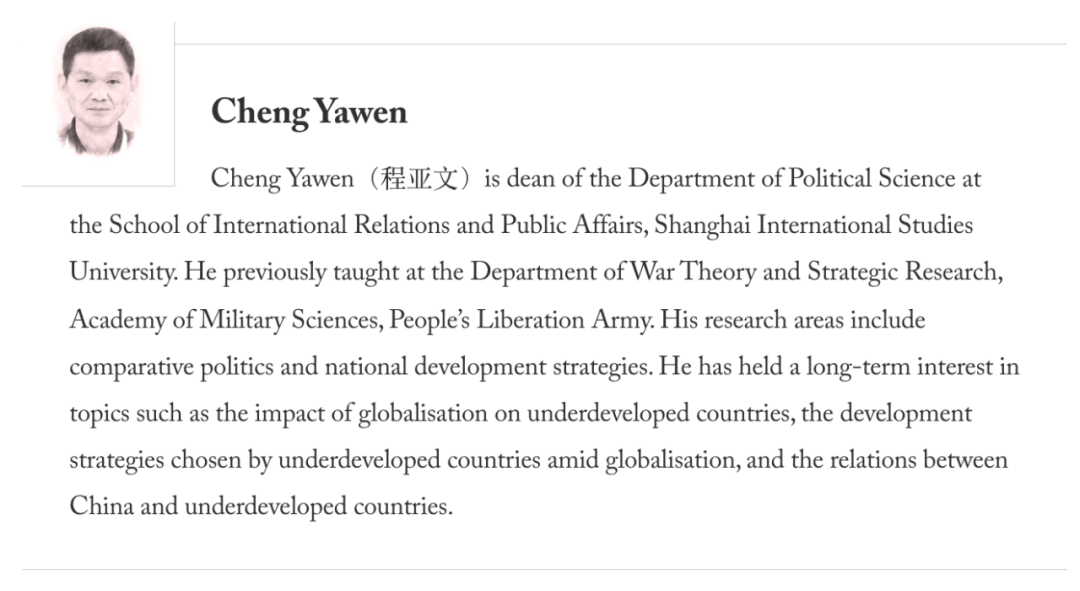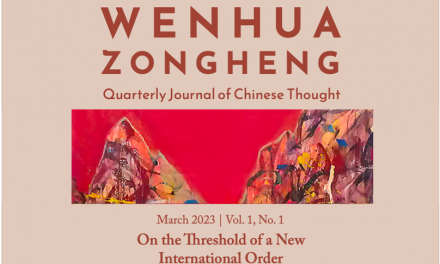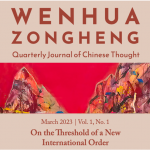Building the New ‘Three Rings’: Reconfiguring China’s Foreign Relations in the Face of Decoupling

The ‘special military operation’ launched by Russia against Ukraine, along with the attendant stalemate that has set in between the West and Russia, are landmark events that signal the approaching end of the globalisation wave that began in the 1980s. The absurd efforts of the United States to bully its allies into enacting murderous sanctions against Russia and to browbeat other countries into taking sides in this conflict, have brought the world to a state reminiscent of the deadly global struggles of the twentieth century ago. These developments pose a major challenge to China; the end of this wave of globalisation means that the country will no longer have the same external environment for development that it has enjoyed for the past forty years, and that the US will likely intensify its push to re-establish its domination over the international system and to decouple from China and Russia. The world has undergone a paradigm shift. In the face of a potential forced and complete decoupling from the United States and Western countries, China must take initiative and adjust its foreign strategic orientation, reprioritising the countries that it engages with in order to develop a new international order that would safeguard against the repercussions of this decoupling.
The Unspoken Rule of the International Order: The Centre-Periphery Power Structure
During the three decades since the collapse of the Soviet Union, relations between Russia and the West have vacillated. Initially, Russia pursued friendly ties with the US and Western countries, then it gradually grew apart from them, and now it has entered into a fierce confrontation. The evolution of this relationship reflects the political limits of globalisation. Unlike the romantic notions of globalisation that were ascendant following the end of the Cold War, in reality, this era saw the establishment of US hegemony and the dismemberment of the Soviet Union and the socialist camp. This process of globalisation and the US pursuit of global supremacy are two sides of the coin; they condition and promote each other. The inability of this system to promote international equality, with developed and developing countries locked into a relationship of dominator and follower states, means that it cannot continue endlessly. On the one hand, globalisation is abandoned, reversed, or redesigned when it backfires on its initiators, threatening their superiority; on the other hand, countries will continue to resist when powerful states relentlessly pursue domination. Russia’s special military operation against Ukraine was the result of the domineering nature of this round of globalisation, and has brought the US-dominated system to a standstill.
The decades-long eastward expansion of the North Atlantic Treaty Organisation (NATO) was the main reason for Russia’s preemptive strike. This military buildup was not only a security issue but also an economic issue, as part of US efforts to marginalise Russia. Russia’s efforts to leverage globalisation to achieve national development and become a central country in the world order, ran counter to the logic of US-led globalisation. Global capital, financial capital in particular, has mainly concentrated on Russia’s energy, grains, and minerals, sectors which it can exploit for extravagant profits. However, during the tenure of Russia’s President Vladimir Putin, the state has strengthened its grip on key sectors concerning national security and people’s livelihoods, and has sought to build a Eurasian economic union to create space for its own economic growth; all of this has upset foreign capital. NATO’s eastward expansion is a manifestation of capital’s control over politics to achieve market expansion. If Russia cannot respond effectively to the efforts to squeeze its development space and exacerbate its marginalisation, it will become even more deeply confined to being a producer of primary goods and lose access to great power politics, increasing the likelihood of a domestic political crisis, which Russian elites wish to avoid.
The power structure of the contemporary world order has been laid bare by NATO’s eastern expansion and the comprehensive sanctions regime imposed by Western countries on Russia. In the aftermath of the Second World War, the European colonial system began to fade out and, during the last half of the twentieth century, the world order became centred on the United Nations and international law, namely the principle of the sovereign equality of states. However, the hierarchical centre-periphery order of the European colonial system has not actually disappeared, but instead continues to exist in an implicit and hidden manner. The absolute power hierarchies which were enforced by colonial diktat have been replaced by an international order based on ‘common but differentiated’ responsibilities, in which states are sovereign equals on the surface but unequal in their actual operation of power. Although the United States and its allies refer to this international system as a ‘rules-based’ order where every nation is bound to observe the same rules, in fact, it revolves around the West rather than the UN and international law.
Post-war US hegemony is the modern incarnation of the global centre-periphery order. The international Group of Seven (G7), established in the 1970s, holds annual meetings at which Canada, France, Germany, Italy, Japan, the United Kingdom, and the United States discuss not only the affairs of these seven countries, but also global issues for which they negotiate and determine international rules. The so-called rules-based order is indeed an order based on the rules made by Western countries and their allies. What matters here is who makes the rules. In this global system, the division of labour, money supply, industrial production, and rulemaking are the exclusive purview of a select few countries. The advantageous position of these countries would be broken up if other countries attempted to join their club, disrupting the rulemaking authority, monetary dominance, and technological superiority maintained through the intellectual property rights regime. China’s unexpected economic rise in recent decades has broken precisely this post-war centre-periphery world order, threatening the structural privileges of the Western countries, which had never imagined that China could enter the centre of the global stage (even if China is only approaching this position and has not yet arrived). As a result, the United States has labelled China as its ‘strategic competitor’ in recent years and demonstrated its willingness to use any means to halt China’s development.
Both NATO’s eastward expansion and Washington’s attempt to contain China suggest that the US and Western countries only seek to maintain and reinforce their own positions of power in the world order. The Russia-Ukraine conflict and the comprehensive Western sanctions against Russia have further underscored the truth about the global system: the majority of the world find themselves in the ‘countryside’ of the global periphery whereas only a select few countries sit in the ‘cities’ of the global centre, at the core of which is the United States. These countries do not wish to see the ‘countryside’ turn into ‘cities’, as they are. China and Russia hinder the global ‘city centre’ in two key aspects: on the one hand, due to their strong capacity to control capital, the two countries are the largest remaining territories in the world that have not been subject to the arbitrary domination of capitalist globalisation; on the other hand, their national strength is much greater than most countries and impedes efforts of the ‘city centre’ to further control the ‘countryside’ of the global periphery. During this wave of globalisation, China has departed from the ‘countryside’ for the ‘city’ with its strong economic growth and overall growth in national strength. The countries at the centre, despite their earlier enthusiastic praise for globalisation, are now leading ‘deglobalisation’ efforts, exposing the limits of the universality of the post-war international order. China and the other nations of the ‘countryside’ joining the ‘cities’ is simply intolerable to the central countries.
The Base of Support for Multilateralism Is in the Global South
Since the 1980s, China has pursued reform and opening up and promoted international cooperation, including, over the last decade, advancing a proposal for the building of ‘a community with a shared future for humanity’ (人类命运共同体, rénlèi mìngyùn gòngtóngtǐ). These efforts can be traced back to the ancient Chinese idea of ‘the great unity under heaven’ (天下大同, tiānxià dàtóng); however, this ‘great unity’ cannot be achieved by China’s desire alone. In the current context of all-out hostility from the US-led West towards Russia and China, the world can no longer be viewed in a mechanical manner and simply assumed to be united around peace and development. Instead, it is necessary to seriously consider the threats of competition, conflict, and war; even if war is excluded from the likely outcomes, it is clear that it is no longer possible for China to continue to pursue its path of development in the Western-dominated system of globalisation. As such, China must reassess its answer to the primary question in foreign relations: which countries are potential partners for China, now and in the future, and which countries will China find it difficult to establish or maintain partnerships with?
As a well-known Chinese idiom goes, similar things group together and similar people fit together (or, birds of a feather flock together). The same applies to nations; those nations which share similar experiences, contexts, and challenges are more likely to form an enduring cooperative relationship. Since the nineteenth century, the world has undergone a global transformation driven by three key components, industrialisation, rational state-building, and ideologies of progress, shifting from a polycentric world with no dominant centre to a highly interlinked and hierarchical core-periphery order in which the centre of gravity resided in the West. Between the mid-to-late nineteenth century and the early twentieth century, imperialism and globalisation were two sides of the same coin: imperialism has driven globalisation while globalisation reinforced imperialism. Together, these related processes have trapped the peripheral nations of the world in a prison of underdevelopment, from which it is extremely difficult to break free. The West, as the former centre of the international system and the birthplace of imperialism, produced both the modern colonial order as well as the system of US hegemony that has dominated the world since the mid-to-late twentieth century. Meanwhile, many revolutionary movements, namely the anti-colonial struggles of the past century, have fought to overcome the inequality and injustice of this global centre-periphery power structure.
In this unequal world order, the central countries do not fairly welcome peripheral countries to the centre and oppose revolutions in the periphery. Consequently, to liberate themselves from subordination and exploitation, peripheral countries have to work together and, occasionally, exploit the rifts between those states at the centre, tactically cooperating with central states when it can advance the struggle. Over the past century, during the Chinese Revolution and the consolidation of state power, the main external forces that China depended on for support came from the global periphery. In the first half of the twentieth century, the Communist Party of China (CPC) was a member of the Communist International, an alliance of state and nonstate actors among the colonised and oppressed peoples of the world. During the War of Resistance Against Japanese Aggression (1931–45), China joined the World Anti-Fascist War, upheld the anti-imperialist banner, and furthered the struggle to dismantle the unequal global structures created by imperialist states. After the People’s Republic of China (PRC) was founded in 1949, China placed a great deal of emphasis on cooperation with the countries of the Third World and supported the anti-colonial movements and post-independence development across Asia, Africa, and Latin America. Of particular importance was China’s active participation in the Bandung Conference of 1955 – an important step in the eventual creation of the Non-Aligned Movement in 1961 – where its proposal of the Five Principles of Peaceful Coexistence (和平共处五项原则, hépíng gòngchǔ wǔ xiàng yuánzé) for international relations was well received; the conference became a milestone in China’s relations with the Global South, where cooperation and solidarity gained positive momentum. It was with the support of peripheral countries that the PRC regained its rightful seat in the United Nations in 1971 and became a permanent member of the Security Council.
The mutual solidarity and support between China and the countries of Asia Africa, and Latin America has remained a key feature of China’s approach to international relations, which emphasises multilateral cooperation with developing countries of the Global South to defend national sovereignty and development in a joint struggle against the unequal and unjust international order structured by the central countries. Despite focusing on relations with peripheral countries, under the framework of ‘omnidirectional diplomacy’ (全方位外交, quán fāngwèi wàijiāo), China remains open to engaging and developing friendly cooperation with Western developed countries and other major powers. However, it should be noted that, in the past, the interaction and cooperation between China and the countries at the centre always bore two preconditions: on the one hand, China insisted on developing foreign relations premised on independence, equality, and mutual benefit, and opposed the existing power hierarchies in international relations; on the other hand, the central countries placed a ceiling on their collaboration with China, namely, the position of Western countries at the centre of the global power structure could not be altered. Whenever either of these two preconditions were not met, China, as a member of the developing world, faced serious challenges in deepening its cooperation with the Western countries, especially on political matters.
Adjusting the Geographic Priorities of China’s Foreign Relations
Over the last forty years, setting aside ideological differences and institutional disparities between countries, China has sought to work with all the other nations. Gradually, China’s international relations came to be guided by the following logic: the major powers are the key; surrounding areas are the first priority; developing countries are the foundations; and multilateral forums are the important stage. However, as the current era of globalisation comes to an end, this approach has increasingly encountered obstacles. The US-initiated process of decoupling from China in terms of economic, technological, knowledge, and people-to-people exchanges – a process that Washington has coerced other Western countries into joining – is unlikely to be reversed and instead, due to the Russia-Ukraine war, it could intensify even further.
Since its founding in 1949, the PRC has undergone several significant shifts in its foreign policy direction, all of which occurred in response to specific historical situations; from the advocacy of the Five Principles of Peaceful Coexistence in the early years of the PRC, to the Three Worlds Theory proposed amid the normalisation of the China-US relations in the 1970s, to the emphasis on developing partnerships with Western countries as part of the transition to reform and opening up after 1978. The contemporary situation is defined by, what China’s President Xi Jinping has called, ‘major changes unseen in a century’ (百年未有之大变局, bǎinián wèi yǒu zhī dà biànjú) and the increasing tendency of Western states to suppress challenges to their authority. Especially in the period since war broke out between Russia and Ukraine, Western states have revealed their willingness to gang up on, pressure, and contain developing countries, a feature of the current Western-dominated order that will undermine international relations for some time. China cannot help but be highly alarmed by the punitive measures that the West has imposed on Russia, as they could also be imposed on China in a similar manner in the future. For this reason, it is urgently necessary that China re-examines its multilateralist tradition and re-orients the geographic configuration of its foreign relations, strengthening its partnerships with developing countries of the Global South to foster a new international environment that is conducive to China’s national security and long-term development.
In 1974, Mao Zedong set forth his Three Worlds Theory, which categorised the countries of the world into three major groupings, each necessitating a distinct approach to engagement from China. The third grouping, the developing countries of the Third World, were the main focus of China, which itself was also part of the Third World; the Chinese government and people firmly supported the just struggles of all the oppressed peoples and nations. Drawing on China’s previous practices and experiences in foreign relations, the theory outlined spatial priorities for China’s ties with other countries and provided an important ideological guide to the country’s approach to South-South cooperation. This theory remains highly relevant and should guide the present-day reconfiguration of the spatial priorities of China’s foreign relations. Contrary to the emphasis placed on working with Western countries since reform and opening up began four decades ago, China now needs to foreground the advancement of the South-South project.
Whether it concerns diplomatic affairs, long-term development, or national rejuvenation, for a considerable period of time, China’s foreign strategic arrangements will have to prioritise engaging with countries of the Global South. China should configure its foreign relations and promote the construction of a new global order under the ‘three-ring’ (三环, sān huán) framework. The first ring refers to China’s neighbouring regions of East Asia, Central Asia, and the Middle East, which present important resource, energy, and security considerations; the second ring refers to the developing countries of Asia, Africa, and Latin America, with which China engages in trade, investment, and infrastructure projects, and to which China mainly delivers its foreign aid; finally, the third ring refers to the United States, European countries, and other industrialised countries with which China exchanges industrial products, technologies, and knowledge.
Within the new ‘three ring’ framework, China’s first and foremost priority in helping to build a new international system should be the first ring, namely East Asia, Central Asia, and the Middle East. To further promote East Asian economic integration and linkages with Central Asia and the Middle East, it is necessary to strengthen engagement and cooperation between Asian countries.. In recent years, by promoting economic diplomacy, China has made considerable progress in advancing East Asian economic integration and economic cooperation with many Asian countries. The latest breakthrough in East Asian economic integration was realised on 1 January 2022, when, after years of negotiation, the Regional Comprehensive Economic Partnership (RCEP) finally entered into force. However, economic exchanges among East Asian countries have been increasingly affected by extra-regional forces and security issues in recent years, with disputes over maritime rights in the South China Sea and Washington’s ‘Indo-Pacific’ strategy fuelling uncertainty in the region. To prevent external forces from exploiting internal problems in Asia, China should move away from the ‘GDP supremacy’, or a narrow focus on economic matters, which it prioritised previously in its foreign relations, and pay greater attention to political and security agendas in the region, promotinge more security cooperation among Asian countries.
South-South Cooperation is the Material Basis of the New ‘Three Rings’
The material basis for the new ‘three rings’ framework is South-South cooperation, a concept that emerged in the late twentieth century regarding mutual interests, support, and solidarity among Third World countries. In the twenty-first century, a new foundation for South-South cooperation is being laid, making the concept more achievable in reality. The main reason for this is that, in recent decades, a number of developing countries in Asia, Africa, and Latin America have been able to industrialise or quasi-industrialise by ‘climbing up the borrowed ladder’, seizing the opportunities afforded by the wave of globalisation. Among these countries, a new global system of material production and circulation has taken shape, and is on track to eclipse the original ‘ladder’ of globalisation built by Western countries. This new global system has manifested in two important respects.
First, the share of developing countries in the global economy has changed significantly. In 1980, developed countries accounted for 75.4 percent of global GDP while developing countries accounted for less than 25 percent; however, by 2021, the former group’s share of global GDP had fallen to 57.8 percent while the latter’s share rose to 42.2 percent. The combined GDP of the BRICS countries (Brazil, Russia, India, China, and South Africa) plus Turkey, South Korea, and Indonesia, in purchasing power parity (PPP) terms, jumped from 21 percent of the global economy in 1992 to 37.7 percent in 2021, while the combined share of G7 countries declined from 45.8 percent to 30.7 percent in the same period.
Second, trade and reciprocal investment between developing countries have also become pivotal. From 1997 to 2010, trade between China and African states increased 22.4 times and trade with Latin American states increased roughly 22 times; and from 2010 to 2021, China-Africa and China-Latin America trade increased another 2 times and 2.5 times respectively. From 2000 to 2018, trade between China and Arab states ballooned from $15.2 billion to $244.3 billion, a 16-fold increase in less than twenty years. Other emerging economies, such as Brazil and India, have sharply increased their trade with developing countries. From 2003 to 2010, Brazil’s trade with Arab states increased four-fold, while its trade with African states increased five-fold, reaching a total of $26 billion, a figure higher than Brazil’s trade with traditional trading partners such as Germany and Japan; and from 2010 to 2019, Brazil’s trade with Arab and African states increased by 98 percent and 68 percent, respectively. Similarly, since 2001, India’s trade with African states has grown at an average annual rate of 17.2 percent and, from 2011 to 2021, it increased 2.26 times. India’s trade with Latin American states as well as the Middle East and North Africa region, has experienced similar growth. Trade volumes between developing countries are growing at a faster rate than the global average, while trading with developed countries continues to decline.
Within the developing world, a particularly important network of economic cooperation has emerged in Asia, centring around China. This is demonstrated in the following four trends:
- Asia is once again the world economy’s centre of gravity. In 1980, the developing countries of Asia accounted for only 13.7 percent of global GDP, however, their share would rise to 24.7 percent in 2010 and reach 35.8 percent in 2021. For East Asian countries (including China, Japan, South Korea, and ten Southeast Asian countries), in 1980 their share of global GDP was only about 16.2 percent, but by 2020 it had more than doubled, reaching 30 percent. Meanwhile, among the fifteen member countries of the RCEP, by 2020, their combined population reached 2.27 billion, cumulative GDP hit $26 trillion, and total imports and exports surpassed $10 trillion, accounting for about 30 percent of the global total. According to HSBC, the cumulative size of the RCEP economies is estimated to expand to 50 percent of the world economy by 2030.
- Global trade and investment are also shifting to Asia, with its share in global trade having steadily increased from 15.7 percent in 1980, to 22.2 percent in 1990, to 27.3 percent in 1995, to 26.7 percent in 2000, to 25.6 percent in 2001, and further to 36 percent by 2020. Today, Asia is the world’s leading trading region.
- The level of intra-regional trade dwarfs that of extra-regional trade in Asia. Between 2001 and 2020, Asia’s total internal trade jumped from $3.2 trillion to $12.7 trillion, with an average annual nominal growth rate of 7.5 percent; during the same period, Asia’s share of total world trade increased from 25.6 percent to 36.0 percent. In 2020, Asia’s intra-regional trade has accounted for nearly 58.5 percent of its entire foreign trade.
- East and West Asia are growing closer economically; the main destinations of Middle Eastern energy have shifted from the United States and Europe to East and South Asia.
Today, developing countries have formed the preliminary structure for a new global economic system, but further synergy between them is needed to achieve a higher degree of economic connectivity as well as greater political influence in the international arena and freedom from Western control and coercion. This past decade, China has become the world’s largest real economy (concerning the production and exchange of goods and services) and the second largest economy overall, as well as the largest trading partner of most countries in the world. In 2021, the global share of China’s manufacturing sector was nearly 30 percent. As the country that produces the most material goods in the world, China is in a similar position as the United States was in the post-Second World War period (at its peak, in 1953, the US accounted for roughly 28 percent of global industrial output). What China can and should do is to take initiative in driving a global strategy to improve the system of global material exchange among developing countries, that is, to truly realise South-South cooperation.
However, deficiencies still remain. Current trade and investment between developing countries still rely heavily on Western-led financial and monetary networks. If developing countries are to further enhance their economic and political autonomy, and if emerging economies are to gain levels of political influence in the world system commensurate with their economic scales, they must overcome their financial and monetary dependence on the West. Therefore, to build a ‘new three ring’ international system, developing countries must consider not only traditional geopolitical factors, but also the global systems of finance and information. In recent years, China has explored this by developing currency swaps with several emerging market economies. A higher-level and broader mechanism for financial and monetary cooperation should be created among developing countries. To this end, it is important to take advantage of existing platforms and mechanisms that can enhance South-South cooperation, including: upgrading and transforming the Asian Infrastructure Investment Bank (AIIB) and the New Development Bank (NDB) established by the BRICS countries to advance an autonomous international payment system; strengthening security and financial cooperation within the framework of the Shanghai Cooperation Organisation (SCO), particularly between China, Russia, India, and Iran cooperation (it should be noted that Russia is also a developing country and that the Chinese and Russian economies are highly complementary); further promoting East Asian economic integration under the framework of the Belt and Road Initiative (BRI), with special efforts to consolidate the achievements of the RCEP; building a common energy market in Asia, so that buyers in East and South Asia and sellers in the Middle East, Central Asia, and Russia can share the same energy trading and payment network; making proper use of the BRICS Summit mechanism, thus deepening South-South cooperation; and promoting the diversification of the international monetary system and the internationalisation of the RMB in the context of South-South cooperation, as well as supporting the international status of the euro while hedging against the hegemony of the US dollar.
One hundred years ago, the CPC leaders proposed the revolutionary strategy of ‘encircling the cities from the rural areas’ (农村包围城市, nóngcūn bāoweí chéngshì). In the present era of ‘major changes unseen in a century’, China and developing countries need to dismantle the centre-periphery world order, overcome the hostility of Western countries, and improve solidarity and cooperation within the global ‘countryside’. The deepening of South-South cooperation will create favourable conditions and mobilise resources for the construction of a new ‘three ring’ global system, which can ease international tensions and allow developing countries, including China, to take their rightful places at the centre of the world economic and political order. After more than forty years of reform and opening up, China must adjust its understanding of ‘opening up’ and transform its thinking about foreign relations. Of course, China should still try to maintain its cooperation with the West as long as possible and as long as they do not make the choice to go completely against China.
构建“新三环”:面对全面脱钩可能的中国选择
俄罗斯对乌克兰发起“特别军事行动”,以及随之而来的西方国家与俄罗斯陷入全面对立,是20世纪80年代以来的全球化大潮走向终结的一起标志性事件。美国挟持盟友对俄罗斯展开欲置之于死地的制裁,威逼世界其他国家在西方国家与俄罗斯之间选边站队,已使世界正在重现百年前你死我活的争斗场景,也给中国带来巨大挑战。“全球化终结”使中国不再拥有过去四十年来的外部发展环境可资利用,美国推动重建以其为主导的国际体系并与中国和俄罗斯“脱钩”的进程,未来极有可能进一步强化。当今世界的时代特征,已发生范式性变革。面对被动全面脱钩的可能情况,中国需要在对外战略安排上主动做出调整,在国家交往优先性上重新做出选择,以塑造有利于对冲西方国家对华脱钩负面影响的新型国际体系。
▍国际秩序的潜规则是中心-边缘权力结构
苏联解体后三十年间,俄罗斯由起初积极向美国和西方国家靠拢,到逐渐与之疏离,以至当前不惜激烈对抗,凸显出全球化的政治限度。与人们对全球化的浪漫想象不同,最新一轮的全球化最初是美国霸权的投资品,部分服务于瓦解苏联和社会主义阵营的目的,这决定了它不可能无限扩展。从全球化的主导型国家与跟随型国家,或发达国家与发展中国家的关系来说,则存在着国际政治的平等限度:当全球化对发起者发生反噬,威胁到其权力优势时,全球化必然会发生“逆转”,运行路径会被重新设计。最近几十年来的全球化进程与美国的权力优势追求是一枚硬币的正反面,二者互为条件、彼此共进。俄罗斯对乌克兰发动“特别军事行动”,是这一轮全球化已经完全暴露其权力本相的结果,也给由美国主导的全球化画上了句号。
北约东扩是俄罗斯主动出击的主要理由。这看起来是个安全问题,其实也是全球化进程中的经济问题。将苏联在全球体系中外围化,是美国发起的全球化进程的目标,俄罗斯意欲借助全球化实现国家复兴、成为中心地带国家,显然与其发生和演进逻辑正相违背。全球资本特别是金融资本对俄罗斯的兴趣,更多集中在能源、粮食和矿产等方面,这是金融资本可以从中谋取巨利的领域。但普京执政以来,俄罗斯加强了对关乎国家安全和基本民生的关键产业的控制,并致力于构建欧亚经济联盟,塑造一个适合于自己的经济发展空间,这是外部资本不乐见的。北约东扩正是资本左右政治实现市场扩张的体现,其不断挤压俄罗斯的发展空间,加剧俄罗斯的外围化,如不能做出有效应对,俄罗斯将被进一步定格在初级产品提供者的位置,丧失参与大国政治的能力,甚至出现内政危机。这是俄罗斯精英阶层不愿看到的。
北约东扩以及当前西方国家抱团对俄罗斯疯狂制裁,已将当代世界的权力结构显露无遗。“二战”结束以后,欧洲殖民体系逐渐瓦解,20世纪下半叶以来国际秩序的明规则,是以联合国和国际法为中心,体现的是国家主权平等原则。但欧洲殖民体系下的中心-边缘等级性国际秩序并没有真的消失,而是作为潜规则和隐秩序一直延续至今,只是以往以直接驱使为特征的绝对等级性权力关系已不复存在,代之以“共同而有差别”的国际秩序,即所有国家在明面上主权一律平等,但在实际运行上仍存在着权力差别。“以规则为基础的秩序”是这种秩序的主要表达,所有的国家都需要遵守相同的规则,但这个规则的真实内涵,并不是以联合国和国际法为中心,而是以西方国家为中心。
战后以来的美国霸权和20世纪70年代后建立起来的七国集团,是当代版本的全球性中心-边缘秩序的主要体现,七国集团每年的年会,讨论的不仅仅是七个国家的事情,也是整个世界的事情,它们商议好了再推动转变为全球规则。“以规则为基础的秩序”,其实是“以西方国家制定的规则为基础的秩序”,谁是规则制定者,才是关键所在。在全球性的分工体系中,规则制定、货币供给和工业品生产,是少数处于中心地带的国家的事情,其他国家如果也想加入其中,就有可能瓦解少数国家的优势地位,这是掌握规则制定权和货币主导权,并以知识产权维持技术优势的国家不愿意看到的。中国在最近几十年来出人意料的经济增长,所打破的正是战后以来的中心-边缘国际秩序,威胁到了以西方国家为中心的潜规则,近些年来美国将中国定义为主要“战略竞争对手”,摆出一副不将中国打垮不罢休的架势,主要原因就是中国的发展已经触动美国和其他西方国家的奶酪,后者从没有设想过中国也可以“走进世界舞台中央”,哪怕目前其实只是“走近”。
无论是北约东扩还是美国将中国选定为重点打压对象,都反映出美国和西方国家想要维持和强化的是自身的权力优势。俄乌冲突以及西方国家对俄无所不用其极的制裁措施进一步凸显的实相,是全球大多数国家处在边缘地带的“农村”,少数国家处在中心地带的“城市”,美国又是全球“城市中心”中的“市中心”,“城市”并不想看到“农村”也像它们一样变成“城市”。中国和俄罗斯对全球“城市中心”的妨碍,既在于两国对资本的强管控能力,成为资本主义全球化最后两块最大的未自由支配之地;也在于两国因其相较大多数国家强大得多的国家实力,而成为“城市中心”进一步控制全球“农村”边缘地带的障碍。在这一轮全球化进程中,中国以其强劲的经济增长和国家实力的全面提升,表现出由“农村”向“城市”进发的趋势,中心地带国家一反早期对全球化的溢美,转而在近年来成为“逆全球化”的引领者,这将战后国际秩序的“共同”限度暴露无遗。中国也成为“城市”中的一员,是中心地带国家所无法容忍的。
▍中国开展多边合作的基本盘在非西方国家
在《毛泽东选集》的首篇《中国社会各阶级的分析》中,开篇提出一个问题:“谁是我们的敌人?谁是我们的朋友?这个问题是革命的首要问题。”中国过去四十多年来进行改革开放,以及近几年来倡议建设人类命运共同体,在国际交往中已不再刻意强调敌友之分,而是希望在“各美其美,美人之美”中推进“美美与共,天下大同”。但天下能否达成“大同”,并不由中国一家的愿望决定。在以美国为首的西方国家与俄罗斯、中国展现出全面对抗态势的情况下,当代世界的时代特征,已不能机械地认为还是“和平与发展”,而需要严肃地考虑“竞争”甚至“战争”——即便战争的情况可以排除,想一如既往地在由西方国家主导的全球化体系中实现更好的发展,已经没有可能。中国不得不重新思考对外往来中的“首要问题”:谁是当下和未来中国的可能合作者,谁是中国无法拉住的合作对象?
物以类聚,人以群分。国家也是一样,有着相似经历、处境和诉求的国家,更有可能形成长久合作关系。在当代国际关系话语体系中,西方国家vs非西方国家、发达国家vs发展中国家、北方国家vs南方国家是对国家类型的常见区分,发达国家、北方国家大多是西方国家,南方国家、发展中国家都是非西方国家。与发达国家vs发展中国家、北方国家vs南方国家的区分偏向经济层面不同,西方国家vs非西方国家的区分还指向政治和文化层面,暗含了全球权力关系。19世纪以来,在工业化、理性国家建设和“进步的意识形态”三个关键要素的作用下,世界经历了一次“全球转型”(Global Transformation):以往处于离散状态的“无中心的多元世界”,转向了一个高度关联而又等级化的“中心-边缘”全球性国际体系,西方是这一秩序的中心。19世纪后期到20世纪上半叶的革命时代,被频繁谈论的“帝国主义”,就是对这种秩序关系的描述和定性。帝国主义与19世纪中后期到20世纪前期的全球化,乃是一体两面,帝国主义随全球化而来,全球化则强化了帝国主义,二者共同给处于边缘地带的国家设置了一个“铁桶阵”,想从中逸出,殊为不易。西方国家以往是全球体系的中心,也是帝国主义的发生地,近代世界的殖民秩序、20世纪中下叶以来的美国霸权,都由此而来;与此同时,近代以来的诸多革命,包括20世纪中下叶的反殖民运动,要打破的,就是这种不平等不公正的中心-边缘权力结构。
在中心-边缘的全球权力结构中,中心地带国家不可能真心帮助边缘地带国家的革命,也不会欢迎边缘地带国家以平等的方式加入到中心地带国家之列,边缘地带国家欲摆脱被支配、被剥夺的命运,只能依靠边缘地带国家间的抱团取暖,在偶然情况下也要利用中心地带国家间的罅隙,争取与后者实现斗争中的合作。20世纪上半叶的中国革命和20世纪下半叶的政权巩固,中国所依靠的主要外部力量,正是来自全球体系中的边缘地带。中国共产党曾经参与的共产国际网络,是当时被殖民被压迫民族的非政权性力量间的同盟;在抗日战争中,中国借参与世界反法西斯战争之机,延续之前中国革命的“反帝”诉求,进一步推动废除帝国主义国家强加于中国头上的各种不平等权利;1949年中华人民共和国成立后,中国高度重视与“第三世界”国家的合作,支持亚非拉世界的反殖民运动和独立后的国家建设,尤其是1955年积极参与万隆会议和提出和平共处五项原则,得到亚非拉国家的良好呼应,也成为此后中国与亚非拉国家关系进入良性循环的重要节点,在后者的支持配合下,中国于1971年重返联合国并成为安理会常任理事国。
中国与亚非拉国家在反抗殖民统治和国家建设中的相互声援、帮助,奠定了近代以来中国多边主义的一个关键特点,即高度重视与非西方发展中国家的合作,在共同反抗中心国家构建的不平等不公正国际秩序中捍卫国家独立自主和发展进步。在以非西方发展中国家为依托所展开的全方位外交中,中国并不排斥与西方发达国家和其他大国的往来甚至发展友好合作关系。但也要看到,中国以往与中心地带国家的交往和合作始终有两个前提:一是从中国的角度来论,中国坚持在独立自主、平等互惠的前提下发展对外关系,反对国际关系中的权力等级;二是从中心地带国家来论,它们与中国合作,始终也有一个天花板,那就是不能动摇以西方国家为中心的全球权力结构。当这两个前提中的任何一个发生改变时,作为发展中国家一员的中国,就很难继续与西方国家深入发展合作关系,尤其是政治上的合作关系。
过去四十年间,中国放弃意识形态歧异、回避国家制度差别,致力于与所有国家开展合作,逐步形成了“大国是关键、周边是首要、发展中国家是基础、多边是重要舞台”的对外交往格局。但这一格局在“全球化终结”时刻到来之际,已遭遇重重障碍。美国裹挟其他西方国家发起的与中国在经济、技术、知识、人员往来等方面的“脱钩”,不太可能因俄乌战火而撤回,相反可能变本加厉。
中华人民共和国成立以来,已经历多次外交方向的转变,从刚建国时的“一边倒”,到20世纪70年代的“一条线,一大片”和“三个世界”划分,再到1978年后转向改革开放、重点发展与西方国家的合作,都因应了当时情势。在当前“百来未有之大变局”之际,西方国家表现出越来越强的打压潜在挑战者的意向,特别是俄乌战火爆发后,西方国家群体集结、全方面压制非西方国家的态势暴露无遗,并将成为未来较长时间内国际关系的结构性存在。中国不能不高度警惕西方国家对俄罗斯无所不用其极的制裁打压手段未来会如法炮制施加于中国。为此,重新审视中国以往的多边主义传统,调整对外交往的空间格局,加强与非西方发展中国家的合作,以创造有利于保障中国国家安全和长远发展的新型国际环境,迫在眉睫。
1974年毛泽东提出“三个世界”的划分,对当时世界的三种类型国家及中国可以与之交往的方式做了辨析,“第三世界”的发展中国家是中国的主要交往对象,中国自身也是“第三世界”国家中的一员,中国政府和人民坚决支持一切被压迫人民和被压迫民族的正义斗争。“三个世界”理论承接了之前的中国对外交往经验,为当时中国的对外往来在空间优先性上作了排序,也是中国以往参与南南合作的重要思想指导,它对当前中国重构对外往来的空间优先性,依然有很强的启发意义。相比于改革开放以来中国更加重视与西方国家的合作,中国今后要将推动南南合作放在突出位置。无论是寻求外交突围、长远发展还是国家复兴,在未来相当长时间内,中国的对外战略安排都要把主要精力放到推动建设以亚洲及其周围地区为依托的新的全球性体系。其最终结果,是要形成保障中国国家安全和发展的“三环”国际体系:第一环是中国周边的东亚、中亚和中东,东亚连接世界财源,中国与此区域内国家已形成紧密产业分工体系,中亚和中东连接世界资源,中国要背靠此区域内国家获得稳定的能源供应和可靠的安全屏障;第二环是亚非拉广大发展中国家,中国与之进行原材料和工业品交换,中国的对外援助也应主要面向这些国家;第三环则扩展到以欧洲和美国为主的传统工业化国家,中国与之进行工业品、技术和知识交换。以这“三环”结构来安排对外往来的轻重缓急和前后左右,重新规划对外交往的方向和内容。
构建“新三环”国际体系的首要和关键是在“第一环”,即亚洲两翼:一翼是东亚,另一翼是中亚、中东。而要继续深入推进东亚经济一体化进程,加强与中亚、中东的联动,又要以丰富与亚洲国家间的交往议题为前提。过去这些年,中国致力于推进与其他国家间的经济外交,有力推进了东亚经济一体化及与亚洲很多国家的经济合作。东亚经济一体化最新的、有突破意义的进展,是经过多年谈判,区域全面经济伙伴关系协定(RCEP)终于达成并于2022年1月1日正式生效。但东亚国家的经济往来,近年越来越多地受到域外势力和安全因素的影响,围绕南海海洋权益引发的争端、美国的“印太”战略,都给东亚经济一体化进程增添了不确定性。中国应走出以往国际交往中的“GDP至上主义”,重视政治、安全议题,推动亚洲国家间更多的安全合作,避免亚洲内部问题继续被外部力量利用。
▍“新三环”的物质基础:“南南合作”正在塑造新的全球性体系
中国推动建构“新三环”国际体系的国际关系基础是“南南合作”,它是一个老概念,强调的是非西方“第三世界”国家间的相互合作、共同扶持。在20世纪下半叶,南南合作的意义更多是政治性的,发展中国家由于普遍经济不发达、技术水平也较低,相互间的贸易往来、技术交流对彼此的帮助有限,对全球经济的影响也不大。20世纪90年代以来,“南南合作”的概念已逐渐淡出人们视野,中国的国际关系学界对它也已关注不多,但实际上,“南南合作”在新世纪以来正在建立起新的基础,在今天已更加具有现实可能性。主要原因是,最近几十年时间,亚非拉发展中国家在追赶全球化浪潮“借梯上屋”也变成工业化或准工业化国家,从全球物质生产和流通来说,亚非拉发展中国家之间已构成一个新的全球性体系,原先的那只由西方国家搭起来的全球化“梯子”,在它们眼中已褪去神彩。这个新的全球性体系主要有以下表现:
首先,发展中国家的经济体量全球占比今非昔比。1980年,发达国家GDP占全球的78.9%,而发展中国家仅占21%;2021年,发达国家占全球GDP的比重跌至 57.8%,发展中国家则上升至42.2 %。由巴西、俄罗斯、印度、中国组成的金砖四国(BRIC)再加上土耳其、韩国和印度尼西亚,这七个国家按购买力平价计算的国内生产总值总和占全球经济的比重,从1992年18%上升到2021年的 37.36%,而七国集团同期则由51%下降到44%。
其次,发展中国家间的贸易往来和相互投资也已举足轻重。中国与非洲之间的贸易量在1997~2010年间增加了22.6倍,与拉美的贸易增长了22倍;到2021年,中非、中拉贸易相比2010年又分别增长2倍、2.5倍。2000年,中阿贸易额仅为152亿美元,到2018年达到2443亿美元,不到20年增长了16倍。巴西与阿拉伯国家之间的贸易额自2003年至2010年增加了4倍,与非洲的贸易额则增加了5倍,总额达到260亿美元,这一数字高于巴西与德国或日本等传统贸易伙伴的贸易额;到2019年,巴西与阿拉伯国家、非洲的贸易相比2010年又分别增长 0.98倍、0.68倍。2001年以来,印度与非洲贸易额年均增长17.2%,2021年比2011年增长2.26倍。印度与拉丁美洲、中东北非国家的贸易,也经历了类似的增长。印度、巴西等新兴经济体之间的相互贸易和投资也都在迅速升温,发展中国家间的贸易量增长速度高于全球平均增速,而与发达国家的贸易往来则持续下降,这些国家间在初级产品和工业品生产上的分工合作,复制了历史上的全球化物质产品交换方式。
再有,从中国周围来看,亚洲已形成一张共在的经济合作网络。具体表现在:
一、亚洲重新成为世界经济重心。1980年亚洲的发展中国家GDP仅占全球的 12.7%,2010年上升至 20.6%,到2021年已达到31.2 %。其中东亚国家(包括中日韩和东南亚10国)1980年GDP全球占比仅13.7%左右,而到了2020年达到了 28.8%,翻了一倍多。2020年,RCEP15个成员国总人口达22.7亿,GDP达26万亿美元,进出口总额超过10万亿美元,均占全球总量约30%。汇丰银行预测,到2030年,RCEP经济圈的经济体量全球占比将提高至50%。
二、全球贸易和投资重心也不断向亚洲转移。亚洲在全球贸易中的份额由1980年的 15.7%提高到1990年的22.2%、1995年的27.3%、2000年的26.7%、2001年的25.6 %,而到2020年又进一步上升到占世界贸易份额的36%,成为世界主要的贸易集团。
三、亚洲内部贸易水平超出与域外贸易。2001~2020年间,亚洲区域内贸易总额从3.2万亿美元跃升至12.7万亿美元,年均名义增长率达7.5%。同一时期,亚洲占世界贸易总额的比重从25.6%提升至36.0%。2020年,亚洲域内贸易占对外贸易的比重已近58.5 %。
四、亚洲两翼在经济上正在成为一个世界,中东能源的流向已由以往主要向欧美转向东亚和南亚。
时至今日,发展中国家已初步形成全球性的经济体系,但它们之间要达成更高程度的经济联结,以及在国际舞台上产生更为强大的政治影响和摆脱西方国家的控制或强制,还有赖于在经济、政治上进一步联合。这又有赖于少数先走一步、经济社会发展水平更为突出的国家发挥带动作用。21世纪第二个十年以来,中国在成为世界第一大实体经济体、第二大经济体的同时,也已成为世界上绝大多数国家的最大贸易伙伴;中国制造业全球贡献率2021年已接近30%,作为全球生产物质产品最多的国家,所扮演的乃是美国在“二战”结束之际的角色(美国工业产值在其巅峰的1953年,占了全球28%左右)。中国可以做,也应该做的,是在全球战略上积极推动发展中国家间的全球性物质交换体系的完善,即真正实现南南合作。
但还有欠缺。当前发展中国家的贸易往来与相互投资,仍然严重依赖于西方国家提供的金融和货币网络。发展中国家的经济、政治自主性要想进一步提升,新兴经济体要想在世界体系中获得与其经济总量相称的政治影响力,必须摆脱对西方国家的金融和货币依赖。因此,构建“新三环”国际体系,不仅需要考量传统的地缘因素,也要将币缘及信(息)缘作为重要考量。过去一些年,中国与一些新兴市场经济体开展货币互换,已在这方面做出探索。广大发展中国家之间应该发展出更高层次、更广范围的金融和货币合作。为此,需要利用好现有的一些平台和机制,将南南合作提升到新的层次,包括升级和改造亚投行、金砖国家银行,完善自主可控的国际支付体系;加强上海合作组织的安全合作及其框架下的中俄印伊合作尤其是金融合作,需要看到俄罗斯也是发展中国家,中国和俄罗期之间在经济上也是高度互补的;在“一带一路”框架下深入推进东亚经济一体化,特别是巩固RCEP的成果;构建亚洲共同能源市场,使东亚和南亚的能源买方市场与中东、中亚、俄罗斯的能源卖方市场共在一张能源买卖和支付网络;善用金砖国家会议机制,以此引领南南合作的深化;推动国际货币体系多元化和南南合作范畴下的人民币国际化,在对冲美元霸权的同时适当对欧元的国际地位提供支持。
一百年前,中国共产党的领导者们提出了“农村包围城市”的革命之路。在当今“百年未有之大变局”之际,中国和发展中国家要破解当代世界的中心-边缘秩序和西方国家对非西方国家的防范打压,同样要搞好全球“农村”地带的团结合作。新全球性体系的出现和南南合作的深化,将为中国进入世界经济、政治最前台,以及调度全球资源构建“三环”国际体系,化解国际压力和突破重围,创造良好可用条件。在经历四十多年的改革开放后,中国须调整对“开放”的理解,在对外往来的思维上实现新的突破。当然,在尽可能的情况下,中国仍要努力维持与西方国家的合作,只要后者不做出完全与中国为敌的选择,中国就不要放弃与之相向而行。
本文发表于《文化纵横》2022年6月刊,该期目录如下,欢迎订阅纸刊查看更多内容:
— 2022年6月新刊目录 —
▍编辑手记
乌克兰危机与新型国际体系构建
《文化纵横》编辑部
▍域外
摆脱“资源诅咒”?——海湾六国的工业化与经济多元化
张若枫
白宫新一代对华战略操盘手的思想素描
杨博文
▍封面选题:巨变来临——俄乌冲突改变世界
俄乌冲突在2022 年爆发,以出人意料的方式改变着整个世界格局。冲突爆发以来,以美国为首的西方把国际规则作为武器对俄进行轮番制裁,深刻且全面地动摇“二战”后几十年来的国际治理体系,和平与发展的时代主题面临前所未有的挑战。俄乌冲突后的世界将向何处去?
跨越俄乌冲突陷阱:重新思考以规则为核心的国际秩序
曹远征
构建“新三环”:面对全面脱钩可能的中国选择
程亚文
作为帝国间冲突的俄乌战争
张昕
欧洲为什么不能掌控自己的命运?
魏南枝
重振领导力:俄乌冲突中的英国战略
孔元
▍专题:人类文明新形态
强世功
正是在这短短十几年中,中国看待世界的眼光和心态也悄然发生了变化:从凸显中国特色的特殊主义叙事,转向更为包容世界的普遍主义叙事;从追求被西方承认的刻意努力,转向平和心态的自我认同。这种变化最直观地体现在两次奥运会的开幕式上。
王立胜、晏扩明
▍观念
史观重建:从“主旋律”到“新主流”
陶庆梅
2021年《觉醒年代》《山海情》等作品的出现,不但打破了“主旋律”与大众文化之间的界限,在市场上创造出良好的口碑;更重要的是,它们通过开辟一种新的历史叙事方式,呼应了这个时代被掩藏着的某种社会情绪,带动了更多年轻观众的情感,造就了属于这个时代的主流价值。
周安安、吴靖
从“未来人”到“顽童”——日本动漫与社会秩序的张力
潘妮妮
从不同时期的代表性作者与作品中,我们看到了日本动漫文化中未成年人位置的变迁:从改造世界的“未来人”,到被教养的未成年人,再到轻视成人世界并主动疏离的“顽童”。这反映了并不存在一个价值统一的日本动漫文化,正如战后日本成人社会的思潮也并非始终如一。
▍社会结构变迁
“波兰尼时刻”在当代中国
郦菁
中国无法避免全球“波兰尼时刻”重现带来的社会压力和不确定性;并且,由于自身庞大的经济体量和重要的政治地位,中国必将在其中扮演重要的角色。
▍公益理论与公益实践
社会组织专业化的中国实践:慈弘基金会的探索
张婧
▍反思美国模式
重新审视“地缘政治学”——一个世界史的视角
方旭
韩国“单一民族”的神话与现实
郑立菲
《文化纵横》国际传播系列由三大洲社会研究所(Tricontinental: Institute for Social Research, 网站:www.thetricontinental.org)和东声(Dongsheng News,网站:www.dongshengnews.org)协作翻译并制作,有英语、西语、葡语三个版本。每期根据不同主题,从《文化纵横》杂志过往发表文章中,选择3-5篇文章进行编译,预计每季度发布一期。2023年第1期主题为“重构现代世界体系”,主要分析全球紧张局势加剧背景下的俄乌战争的全球影响,追溯中西关系的历史轨迹,并探讨团结广大第三世界国家、推动构建新型国际体系的可能性。










